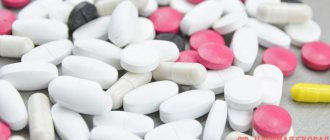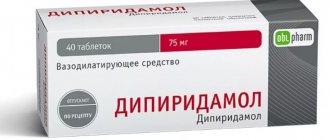Diseases of the retina and choroid can occur in acute and chronic forms. Chronic diseases include dystrophies and degenerations (central and peripheral), angioretinopathy of various natures, inactive and subactive phases of chorioretinitis.
Therapy for these diseases comes down to regular use of medications prescribed by an ophthalmologist. As a rule, it is recommended to take comprehensive courses twice a year, which include up to five types of drugs from several groups. Thus it turns out: 2 months of treatment, followed by a four-month break. It is better to combine one of the annual courses of therapy with local treatment - subconjunctival and parabulbar injections, and leave local instillations for the second annual course.
Drugs prescribed for annual courses of treatment are divided into the following groups: retinoprotectors, angioprotectors, anticoagulants, stimulants, absorbents, improve microcirculation, vasodilators, vitamins and drugs that activate tissue respiration. At the same time, one drug may have several specific properties and be in different groups. And drugs from the same group can have completely different effects on the body. For example, vasodilator drugs sometimes lower blood pressure, do not change it in any way, and in some cases they increase it. In this regard, the schemes of therapeutic courses are built taking into account the individual characteristics of a particular patient. To avoid polypharmacy, it is always better to choose 2 or 3 drugs that are completely suitable for the patient and will have the necessary complex effect on his body.
Tissue respiration stimulants
For this purpose, the enzyme preparation Cytochrome C , which is produced from the heart muscle of cows. The active substance is a participant in the act of tissue respiration and can accelerate oxidative reactions. Known as one of the components of Katachrom drops.
The drug is prescribed as an intramuscular injection of 5 ml. Before starting the course, a test is performed, the frequency of daily injections is 1 or 2. The duration of treatment is up to 20 days.
A test is required before each treatment course. With its help, the individual sensitivity of the patient is determined. As a test, 0.1 ml of Cytochrome C is injected into the skin and observed for half an hour. If redness, itching or allergic rashes occur, individual intolerance is indicated and the appointment is cancelled.
Diagnosis of varicose veins:
- Examination and history taking;
- Duplex scanning of veins;
- Ultrasonography;
- Phlebography of the veins of the extremities;
- Phlebomanometry.
After examining the patient, the doctor determines the need for one or another type of vascular diagnostics. When the disease is diagnosed, the patient is offered the following treatment methods for varicose veins:
- Removal of affected veins (phlebectomy)
- Laser photocoagulation;
- Sclerotherapy (with the help of a special substance, damaged veins seem to stick together and disappear);
- Radiofrequency coagulation of veins.
Angioprotectors
These are substances that help normalize the permeability of vascular walls, reduce swelling of vascular tissue, and accelerate metabolic processes in the vascular wall. The angioprotective effect is fully possessed by: vitamin P, anti-inflammatory non-steroidal drugs, as well as the following medications.
Doxium, the main substance of which is a special form of calcium dobesylate, necessary for strengthening the walls of blood vessels. This drug is needed to increase capillary resistance, improve blood microcirculation, and stimulate drainage function in lymphatic vessels. It thins the blood and slightly reduces platelet aggregation, which has a beneficial effect on the condition of the retinal tissue. Does not have any effect on microaneurysms and does not significantly penetrate the blood-brain barrier.
The tablet form of the drug is prescribed at the rate of 0.75-1.0 g per day, which is 3-4 tablets, which are drunk after meals. The course of treatment is quite long and can last a year or a year and a half.
Among the negative aspects of taking the drug, experts note dyspepsia and allergic skin rashes. This is a reason to reduce the dose or completely cancel it. Not prescribed during pregnancy.
Ascorbic acid is a drug for normalizing the permeability of the capillary wall, improving redox reactions, and regulating carbohydrate metabolism. In addition, ascorbic acid helps reduce cholesterol levels in the blood, accelerate tissue regeneration, and stimulate the production of steroid hormones. This property of the drug is very important if a course of steroid therapy is necessary.
Prescribed in injections or tablets. Dosage for tablets: 0.05-0.1 g up to 5 times daily, with intramuscular administration of a 5% solution - 2.0 ml No. 20-30. Intravenous injections in the same dose are also possible, although it must be taken into account that in the case of thrombosis, thrombophlebitis or increased blood clotting, they are contraindicated.
Flavonoid Rutin is a drug that reduces capillary fragility and permeability (especially in combination with ascorbic acid). Together with it, it is a participant in redox reactions and slows down the action of hyaluronidase.
The daily dose of Rutin is usually 0.1 g, prescribed in combination with ascorbic acid. Ascorutin tablets are mass produced, including rutin with ascorbic acid and glucose. The therapeutic course involves taking them 4 pieces per day. It has no contraindications or side effects.
Troxevasin (venoruton) is a drug with an action close to rutin. Regulates capillary permeability, fights swelling and tissue inflammation. In capsules, prescribed one at a time with meals, for a course of 2-4 weeks.
Divascan is a hemostatic drug that reduces microvascular permeability. Available in tablets, which are prescribed one three times a day. Patients with diabetic retinopathy or intraocular hemorrhages are recommended to take without interruption for at least two years.
Dicynone (etamsylate) is a substance that increases the content of high molecular weight mucopolysaccharides in the capillary wall, which increases their stability and normalizes permeability. The drug has the property of improving microcirculation, normalizing platelet adhesion, and has a hemostatic effect without promoting the formation of blood clots.
Prescribed orally or intramuscularly. The daily dose in tablets is 1.5-2.0 g, duration of administration is 2-3 months. IM injections are prescribed for 10-14 days; they can be combined with subcutaneous administration of this drug at a dose of 0.5 ml.
To prevent bleeding during surgical interventions, Dicynon is administered intramuscularly before and after surgery if there is a risk of postoperative bleeding.
The drug is prescribed with caution to patients with thrombosis and embolism. There are no side effects.
Prodectin (parmidin) is an angioprotector drug whose action is aimed at restoring microcirculation. It helps reduce platelet aggregation, activates fibrinogenesis, and improves the condition of the vascular endothelium. Prodectin has a pronounced anti-sclerotic effect and accelerates the disappearance of signs of intoxication.
Its intake is 4 tablets daily (1.0 g), for a course of up to 6 months.
Side effects include nausea, occasionally allergic skin rashes, and headache. When the dosage is reduced or the drug is discontinued, all phenomena disappear. Contraindications for use are liver disease.
Emoxipine helps reduce blood viscosity, reduce the permeability of vessel walls, and resolve hemorrhages. It is a retinoprotector and antioxidant, protects the retina from the negative effects of bright light (laser coagulation, sunburn). It is prescribed for hemorrhages, retinopathy, complicated myopia, retinal dystrophies, thrombosis of its veins, light or radiation burns of the eyes, and glaucoma. It is also a component of complex treatment for laser coagulation.
Prescribe one injection into the eye (subconjunctival, retrobulbar, parabulbar) of a 1% solution in a dosage of 0.5 ml every day for 10-15 days. If necessary, the course of treatment is extended to 30 days and repeated several times a year. Sometimes the drug is used in the form of eye drops.
Its side effects may include: itching, burning, pain, related to allergic reactions. They are relieved by using corticosteroids. Sometimes during injections, compaction of the orbital tissue is observed, which subsequently resolves on its own.
Drugs that promote resorption
Chymotrypsin is a drug that helps break down blood clots, exudates, and fibrin. Prescribed as intramuscular injections of 5-10 mg in saline solution, lasting 20-30 days.
Fibrinolysin is a drug with high activity against fresh blood, so if the hemorrhage has occurred recently, treatment begins with it. It is prescribed as a sub injection in combination with fibrinolysin and heparin for 10-15 days. If necessary, chymotrypsin can be used after this. If the hemorrhage occurred a long time ago, it is not advisable to administer Fibrinolysin.
Another drug in this group, Lidaza, is contraindicated in recent hemorrhages. And in case of long-standing hemorrhage, it can provoke it again, therefore it is also contraindicated.
Anticoagulants
Heparin , as an active substance, has a multicomponent effect: absorbable, lipotropic, anticoagulant. It is prescribed in the form of intramuscular injections according to the following scheme: the first 4 days, 4 daily injections, the next 4 days, 3 injections, then 4 days, 2 injections and another 4 days, 1 injection.
The dosage is up to 5000 units. The drug is not used in large doses as complications are possible.
Iodine preparations are prescribed to increase the fibrinolytic activity of the blood. In addition, they reduce the content of b-lipids and cholesterol. Prescribed orally 5-10 drops in milk twice or thrice a day, or in the form of pills with a dosage of 0.0005 g. The course of treatment is at least one month, carried out intermittently for many years.
Causes
The causes of vasodilation are hypertension, severe injuries, the last stages of syphilis, atherosclerosis. Moreover, atherosclerosis is the most common of them. The deposition of cholesterol with the formation of plaques in the walls of the arteries causes the causes of vascular atherosclerosis. Because of this, the elasticity of the blood vessels decreases, the walls become weakened. Under the influence of blood pressure, they stratify and aneurysms form. They not only interfere with the normal blood supply to organs: rupture of an aneurysm is extremely dangerous due to the threat of hemorrhage.
Antiplatelet agents
Curantil is a drug that slows platelet aggregation, which prevents the formation of blood clots in blood vessels. It has a vasodilating effect, slightly lowers blood pressure, reduces peripheral resistance, and improves cerebral circulation.
Prescribed as an antiplatelet agent to prevent the occurrence of thrombosis after operations and for blood clots in the central retinal vein. The antiaggregation activity of Curantil is close to that of acetylsalicylic acid. However, this drug is better tolerated and does not have ulcerogenic properties.
Curantil is prescribed orally at a dose of 25 mg three times a day for a long period.
There are side effects of taking the drug, although they are very rare. These include: redness of the face due to a vasodilator effect (short-term), increased heart rate, allergic rash. Not prescribed for widespread atherosclerosis of the coronary arteries.
Acetylsalicylic acid is an anti-inflammatory drug with antithrombotic action and the ability to inhibit platelet aggregation. The drug is used for thrombosis of retinal vessels to prevent the formation of clots.
Prescribed orally 0.125 g or 1/4 tablet after meals once a day. Can be used for a long time.
Tiklid (ticlopedine) has the ability to suppress the aggregation of erythrocytes and platelets, activates the synthesis of prostacyclin and prostaglandins E1 and D2, and improves microcirculation. It is used for retinopathy - diabetic and post-thrombotic.
Tiklid is taken orally 0.25 g with food twice a day for a long time (up to 6 months or longer) under the control of blood composition and liver function.
When taken, diarrhea and epigastric pain may occur. Phenomena of hemorrhages, leukopenia, and agranulocytosis are also possible.
The drug is not prescribed simultaneously with anticoagulants or antiplatelet agents. It is contraindicated in cases of increased risk of bleeding, stroke, exacerbation of stomach ulcers, liver disease, pregnancy and lactation.
Indications for use
Peripheral vasodilator drugs are indicated for circulatory disorders in peripheral organs and tissues associated with narrowing of the lumen of the vessel: atherosclerotic plaque (vascular atherosclerosis obliterans), inflamed vascular wall (endarteritis obliterans), pathological reflex spasm (Raynaud's disease).
Peripheral vasodilators are used for circulatory disorders in the vessels of the lower extremities, which are accompanied by intermittent claudication, trophic ulcers, pain in the legs at rest, sensory disturbances, and spasms in the calf muscles.
Peripheral vasodilators are also used for vascular complications due to diabetes mellitus (diabetic angiopathy), up to the initial stages of gangrene of the foot.
In addition, drugs of peripheral vasodilators are used for chronic disorders of cerebral circulation - cerebral atherosclerosis, dyscirculatory encephalopathy, chronic cerebral vascular insufficiency.
Peripheral vasodilators are indicated for behavioral and mental disorders in old age, in patients after stroke, coma, and insufficient blood supply to the retina and inner ear.
Certain drugs of peripheral vasodilators (bendazole and its combinations with papaverine) are used for arterial hypertension and hypertensive crisis.
Vasodilators
Cinnarizine (stugeron) has an antispasmodic effect, reduces the reaction of blood vessels to vasoconstrictors. The drug improves microcirculation, thins the blood, and increases tissue resistance to hypoxia. Cinnarizine also has antihistamine properties; reduces the excitability of the vestibular apparatus, thereby suppressing nystagmus. Does not significantly affect systemic blood pressure.
The drug is taken orally after meals, 2 tablets twice a day. The duration of treatment can vary from several weeks to several months.
Side effects of the drug include dry mouth, drowsiness, and possible gastrointestinal disorders. Cinnarizine enhances the effects of alcohol and sedatives. There are no contraindications.
Sermion is a drug with antispasmodic activity against retinal vessels. It is used for diabetic retinopathy, corneal dystrophies, ischemic lesions of the optic nerve.
Take 10 mg orally before meals three times a day. Treatment is long - several months.
If phenomena such as hypotension, gastrointestinal disorders, dizziness, drowsiness or sleep disturbances, skin itching, redness of the face or skin of the upper half of the body occur, the dosage should be reduced or the drug discontinued.
Cavinton (vinpocetine) is a drug with vasodilating properties and a direct relaxing effect on smooth muscles. It improves blood flow, promotes glucose utilization, thins the blood, reduces platelet aggregation, and to a small extent reduces blood pressure levels.
Prescribed orally 2 tablets after meals twice a day. The course of admission is 60 days.
Not prescribed for patients with severe ischemia and cardiac arrhythmias, or pregnancy. Contraindicated in case of low vascular tone and labile blood pressure.
Nicotinic acid - the drug has an antipellagritic effect, normalizes cholesterol levels in the blood, affects fat and carbohydrate metabolism, dilates blood vessels, inhibits the sympathetic and stimulates the parasympathetic nervous system.
The drug is taken in tablets twice or three times a day, 0.02-0.05 g. In addition, it can be prescribed as injections of 1-2 ml intramuscularly for 10-15 days.
For ophthalmological pathologies, nicotinic acid is practically not prescribed as an independent drug. However, it is very often part of the used complexes: Xanthinol nicotinate, Nikoverin, Nikoshpan.
Nigexin is a drug with a vasodilator effect without lowering blood pressure levels. Prescribed for a course of up to 6 weeks, 0.25 g three times a day.
Complamin - has a vasodilating effect on peripheral vessels, improves peripheral blood circulation and microcirculation in the vessels of the retina.
The tablets are taken without chewing after meals, 2-3 pieces at a time. For patients with acute myocardial infarction, severe heart failure and bleeding, Complamin is not prescribed. When taking, caution should be exercised by people with stomach ulcers and labile blood pressure.
Trental (agapurine, pentoxifylline) is a drug with vasodilating properties, which improves the supply of oxygen to eye tissue. It improves blood microcirculation and its rheological properties, thins the blood and affects the elasticity of red blood cells.
It is taken in the form of tablets, which I take without chewing after meals. The daily dose is 4 tablets (0.4 g).
Taking the drug may be accompanied by side effects: nausea, redness of the face, dizziness.
In patients with recent retinal hemorrhages, massive bleeding, severe vascular sclerosis, or heart attack, the drug is not used.
Classification of peripheral vasodilator drugs
Peripheral vasodilator drugs are classified according to their chemical structure and origin into:
- 2-amino-1-phenylethanol derivatives: isoxsuprine;
- nicotinic acid preparations: nicotinic acid;
- purine derivatives: xanthinol nicotinate, pentoxifylline;
- ergot alkaloids: nicergoline;
- Vinca alkaloids: vincamine;
- others: naftidofuryl, bendazole, bencyclane.
In addition, magnesium sulfate, hydralazine, antihypertensive drugs - calcium antagonists (amlodipine, nifedipine, felodipine, isradipine, nitrendipine), nitric oxide donors (sodium nitroprusside), potassium channel activators (minoxidil, diazoxide) have a peripheral vasodilating effect.
There are also combination preparations of the peripheral vasodilator bendazole with the myotropic antispasmodic papaverine.
Antisclerotic drugs
Miscleron has the ability to reduce the level of lipids and uric acid in the blood, increase its viscosity and fibrinolytic activity, and reduce platelet aggregation. Due to this, it is widely used for diabetic retinopathy, as well as other conditions associated with hyperlipidemia.
It is recommended to take the drug three times a day, 2 capsules during or after meals. Courses of treatment usually last 20-30 days, followed by an equal break; it is advisable to take 4-6 such courses per year.
Taking Miscleron may be accompanied by: gastrointestinal disorders, skin itching, muscle weakness and pain, weight gain due to water retention. Long-term use of this drug can cause intrahepatic cholestasis and cholelithiasis. Therefore, many European countries abandoned its production.
The drug should not be taken by people with liver and kidney diseases, as well as during pregnancy and lactation. Prescribed with caution to diabetics.
Methionine is a drug containing essential amino acids. Its lipotropic effect is aimed at removing excess fat from the liver. In addition, it has the property of activating hormones, vitamins and enzymes, and neutralizing toxic substances. Methionine is used for toxic liver damage, prescribed for diabetes mellitus, atherosclerosis (to reduce blood cholesterol levels and increase phospholipid levels).
It is taken 2 tablets (0.5 g) before meals 3-4 times daily, lasting from 10 days to a month. Sometimes, the course of treatment is longer: 10 days of taking pills, 10 days of rest.
An unpleasant consequence of treatment with Methionine is vomiting, which requires its discontinuation.
Features of treatment with peripheral vasodilator drugs
Due to the high risk of shock and collapse - a sharp drop in blood pressure with loss of consciousness - peripheral vasodilator drugs are prescribed with caution to people with hypotension (low blood pressure).
Peripheral vasodilator drugs, lowering blood pressure, with a sharp change in the horizontal position of the body to a vertical one, can lead to an outflow of blood from the brain, which is manifested by dizziness and even loss of consciousness. This condition is called orthostatic hypotension. To prevent the development of such an effect after taking peripheral vasodilator drugs, the patient should lie down or sit for about half an hour, without getting up suddenly.
Since peripheral vasodilator drugs thin the blood, having an antiplatelet effect, their use is contraindicated in patients with reduced blood clotting and uncontrolled bleeding.
When using peripheral vasodilator drugs, you should stop drinking alcohol and smoking.
Stimulant drugs
Phibs is a biogenic stimulant produced from distilled mud from estuaries. Prescribed in the treatment of blepharitis, conjunctivitis, keratitis, myopia, vitreous opacities.
It is administered in the form of subcutaneous injections of 1 ml, the course of treatment is 30 injections.
ATP is a substance that regulates the energy metabolism of cellular reactions, mainly during the synthesis of RNA and DNA. Thanks to its action, the processes of alteration and exudation are stopped and redox reactions are stimulated. Subconjunctival administration of ATP results in its accumulation in the eye tissues without complications.
It is prescribed subconjunctivally in 0.2 ml or intramuscularly in 1-2 ml. Course of treatment: 15 subconjunctival injections or 25 intramuscular.
Peat is a derivative of distilled peat. Indications for its use, dosage and course of treatment are similar to the drug FiBS.
Aloe extract is a very effective drug in the treatment of a number of eye diseases: blepharitis, conjunctivitis, keratitis, uveitis, progressive myopia, vitreous opacities, etc.
It is prescribed as a subcutaneous injection in a dosage of 1 ml.
Not indicated for patients with severe cardiovascular diseases, hypertension, acute gastrointestinal disorders, severe kidney diseases. And also for older people.










![Rice. 2. Relationship between dose of diclofenac (D), naproxen (Nap) and etoricoxib (Eto) and effect size in osteoarthritis [3]](https://ms-pi.ru/wp-content/uploads/ris-2-zavisimost-mezhdu-dozoj-diklofenaka-d-naproksena-nap-i-330x140.jpg)